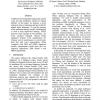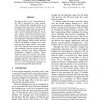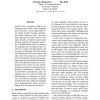84 search results - page 1 / 17 » A New Approach for English-Chinese Named Entity Alignment |
104
click to vote
EMNLP
2004
15 years 1 months ago
2004
Traditional word alignment approaches cannot come up with satisfactory results for Named Entities. In this paper, we propose a novel approach using a maximum entropy model for nam...
ACL
2010
14 years 10 months ago
2010
We observe that (1) how a given named entity (NE) is translated (i.e., either semantically or phonetically) depends greatly on its associated entity type, and (2) entities within ...
83
Voted
ACL
2004
15 years 1 months ago
2004
Most foreign names are transliterated into Chinese, Japanese or Korean with approximate phonetic equivalents. The transliteration is usually achieved through intermediate phonemic...
106
click to vote
ACL
2006
15 years 1 months ago
2006
Named Entity recognition (NER) is an important part of many natural language processing tasks. Current approaches often employ machine learning techniques and require supervised d...
COLING
2002
15 years 4 days ago
2002
A new statistical method called "bilingual chunking" for structure alignment is proposed. Different with the existing approaches which align hierarchical structures like...



